Robert Bosch Car Multimedia 52R0 Car radio & infotainment system User Manual Part 4
Robert Bosch Car Multimedia GmbH Car radio & infotainment system Users Manual Part 4
Contents
Users Manual_Part 4
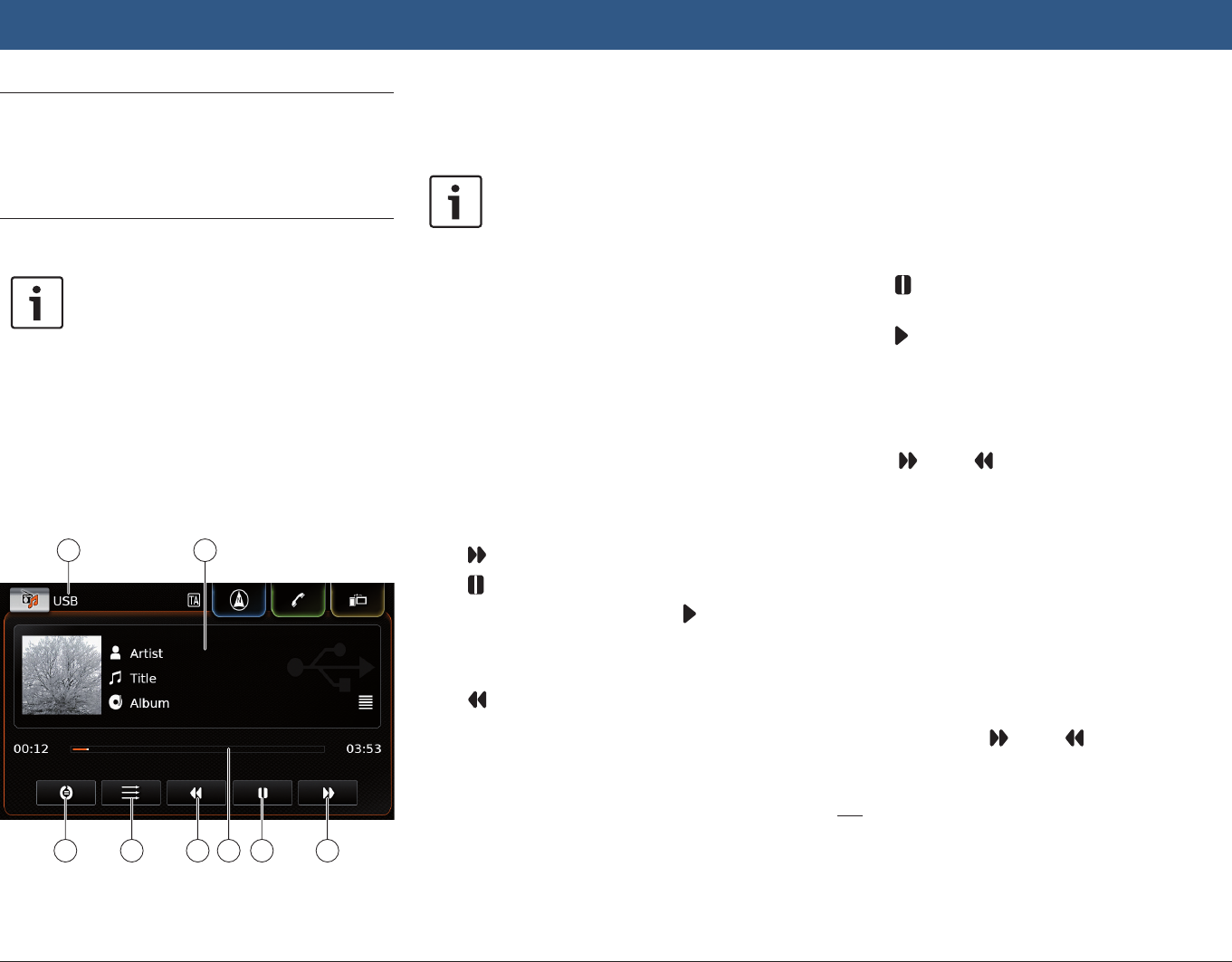
en | 35
7.2 Calling up the audio/video dis-
play
While you are playing media:
fTap the Listen area in the Home menu.
7.3 Audio playback
Note:
The control options that are available
depend on the current audio source:
fBluetooth® devices may employ
communication protocols that do
not support all control options.
fNo control options are available for
AUX playback.
7.3.1 The audio display
31 32
333435363738
You will find the following information and con-
trols in the audio display:
Note:
The information that is available
depends on the current audio source:
fInformation on MP3 tracks must be
stored as ID3 tags on the audio
source.
fBluetooth® devices may employ
communication protocols that do
not provide all the track informa-
tion.
fNo track or playback information is
available with AUX playback.
O Current playback source
P Title information area
Q button: Skip to next title/fast forward
R button: Pause playback
When playback is paused: button:
Resume playback
S Playback progress bar
T button: Skip to previous title/rewind
U button: Shuffle function
V button: Repeat function
The title information area P provides informa-
tion on the current track, audiobook or podcast,
for instance:
fArtist
fTitle
fAlbum
The playback progress bar S displays the
playback position in the current title and the
elapsed and total playing time of the title.
7.3.2 Pausing playback
fTap R.
Playback is paused.
fTap R.
Playback resumes.
7.3.3 Skipping to the next/previous
title
fTap Q or T.
The next or previous title is played.
7.3.4 Selecting titles in the media
browser
fTap the title information area P.
The media browser opens. For further details on
this, please read the section entitled “Media
browser” (page 37).
7.3.5 Fast forward/rewind
fTouch and hold Q or T until you
reach the desired position.
Or:
fTouch the playback progress bar S and
swipe left or right along the bar to alter the
position in the title continuously.
Playing media

36 | en
7.3.6 Skipping forwards/back-
wards in the current title
fTap the desired position in the playback
progress bar S.
7.3.7 Repeat function
fTap the toggle button V to switch between
Repeat off, Repeat track and Repeat selec-
tion.
– Repeat track
: Repeat the current title
– Repeat selection : Repeat the current
playback category (e.g. album, artist,
folder)
– Repeat off
: Deactivate the repeat
function
7.3.8 Shuffle function
fTap the toggle button U to switch between
Shuffle off and Shuffle selection.
– Shuffle selection
: Shuffle the tracks in
the current playback category (e.g. album,
artist, folder)
– Shuffle off : Deactivate the shuffle
function
7.4 Video playback
Safety notice
The displaying of video images is only
possible while the vehicle’s parking
brake is applied. As soon as the park-
ing brake is released, the video image
of a running video file or external DVD
is hidden and the following notification
appears in the display: “For your safety,
the video is off while the vehicle is in
motion.” Playback of the video file or
external DVD continues, and the audio
output can still be heard.
Note:
No control options are available when
playing an external DVD.
7.4.1 The video display
39 40
4142434445
You will find the following information and con-
trols in the video display:
W Current playback source
X Picture area
Y button: Skip to next title
Z button: Pause playback
When playback is paused: button:
Resume playback
[ button: Skip to previous title
\ Playback progress bar
] button: Open media browser
The picture area X provides information on the
current title:
fTitle (not for an external DVD)
fNumber of the current title / of the current
episode (not for an external DVD)
The playback progress bar \ displays the
playback position in the current title and the
elapsed and total playing time of the title (not for
an external DVD).
Note:
In full-screen mode, the symbol
appears in the picture area when play-
back is paused.
7.4.2 Pausing playback
fTap Z.
Playing media
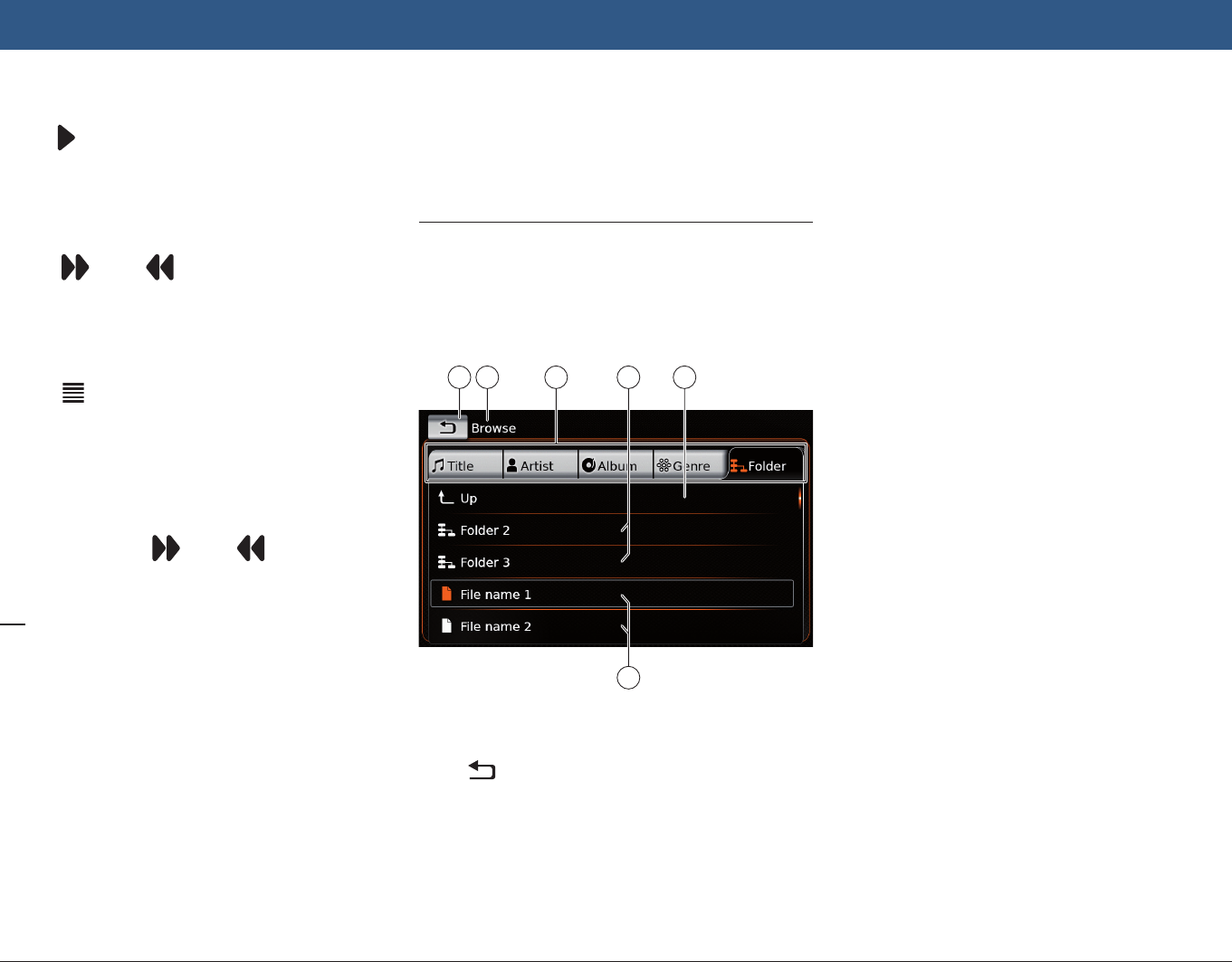
en | 37
Playback is paused.
fTap Z.
Playback resumes.
7.4.3 Skipping to the next/previous
title
fTap Y or [.
The next or previous title is played.
7.4.4 Selecting titles in the media
browser
fTap ].
The media browser opens. For further details on
this, please read the section entitled “Media
browser” (page 37).
7.4.5 Fast forward/rewind
fTouch and hold Y or [ until you
reach the desired position.
Or:
fTouch the playback progress bar \ and
swipe left or right along the bar to alter the
position in the title continuously.
7.4.6 Skipping forwards/back-
wards in the current title
fTap the desired position in the playback
progress bar \.
7.4.7 Full-screen mode – on/off
To switch between the video display and full-
screen mode,
ftap the picture area X.
7.5 Media browser
Using the media browser you can select audio
and video titles for playback.
7.5.1 The browser display
47 4846
51
5049
You will find the following information and con-
trols in the browser display:
a button: Close media browser
b Browse mode indication
c Main categories (here: Folder)
d Subcategories (here: Folders)
e up button: Return to parent category
f Titles/files
In the browser display you can select media
according to various categories, such as artist,
album or genre.
The main categories are:
fTitle:
Select a title from all the available titles. All
titles of the media source are subsequently
played.
fArtist:
Select a title from all of the artist’s titles or
from one of the artist’s albums. Only the titles
of the artist or album are subsequently
played.
fAlbum:
Select a title from an available album. Only
the titles of the album are subsequently
played.
fGenre:
Select a title from an album of the genre or
from the album of a particular artist. Only the
titles of the album are subsequently played.
fFolder:
Choose a title in the folder structure of the
media source. Only the titles contained in the
same folder are subsequently played.
fPlaylist:
Choose a title in a playlist. Only the titles
contained in the same playlist are subse-
quently played.
Playing media

38 | en
fAudiobook:
Select a chapter from an available audio-
book. Only the chapters of the selected
audiobook are subsequently played.
fPodcast:
Select an episode from an available podcast.
Only the episodes of the selected podcast
are subsequently played.
fVideo:
Select an episode from an available video.
Only the episodes of the selected video are
subsequently played.
7.5.2 Selecting titles
fTap the desired main category c.
The corresponding list items are displayed.
Note:
To scroll through the main categories,
touch the tab row.
fTap the desired subcategory, if applicable
d.
Notes:
fTo scroll through list items, touch
the list area and swipe up or down.
fA subcategory can contain further
subcategories.
To return to a parent category, tap
up e.
fTap the desired title f.
Playback begins.
Note:
To display the respective media dis-
play, tap a.
7.5.3 Closing the browser without
selecting a title
fTap a.
The current media display is displayed.
8 Navigation
Note:
This function is only available if the
device is equipped with a navigation
system.
If your device is not equipped with a
navigation system you may be able to
retrofit the navigation function (see the
section entitled “Retrofitting the navi-
gation function” (page 55)). Please
contact your Suzuki dealer regarding
this.
Road safety
fThe usage of the navigation system
does not absolve the driver of the
responsibility of a correct and vigi-
lant attitude. The relevant traffic
regulations must always be fol-
lowed. If a navigation instruction
contradicts traffic regulations, the
traffic regulations always apply.
fThe route guidance provided by the
device may not be completely accu-
rate. Ensure that all driving manoeu-
vres are legal and safe in order to
avoid accidents.
fSome areas – one-way streets,
entrances and other pedestrian
zones, where vehicle entry is pro-
hibited – may not be marked on the
Playing media | Navigation
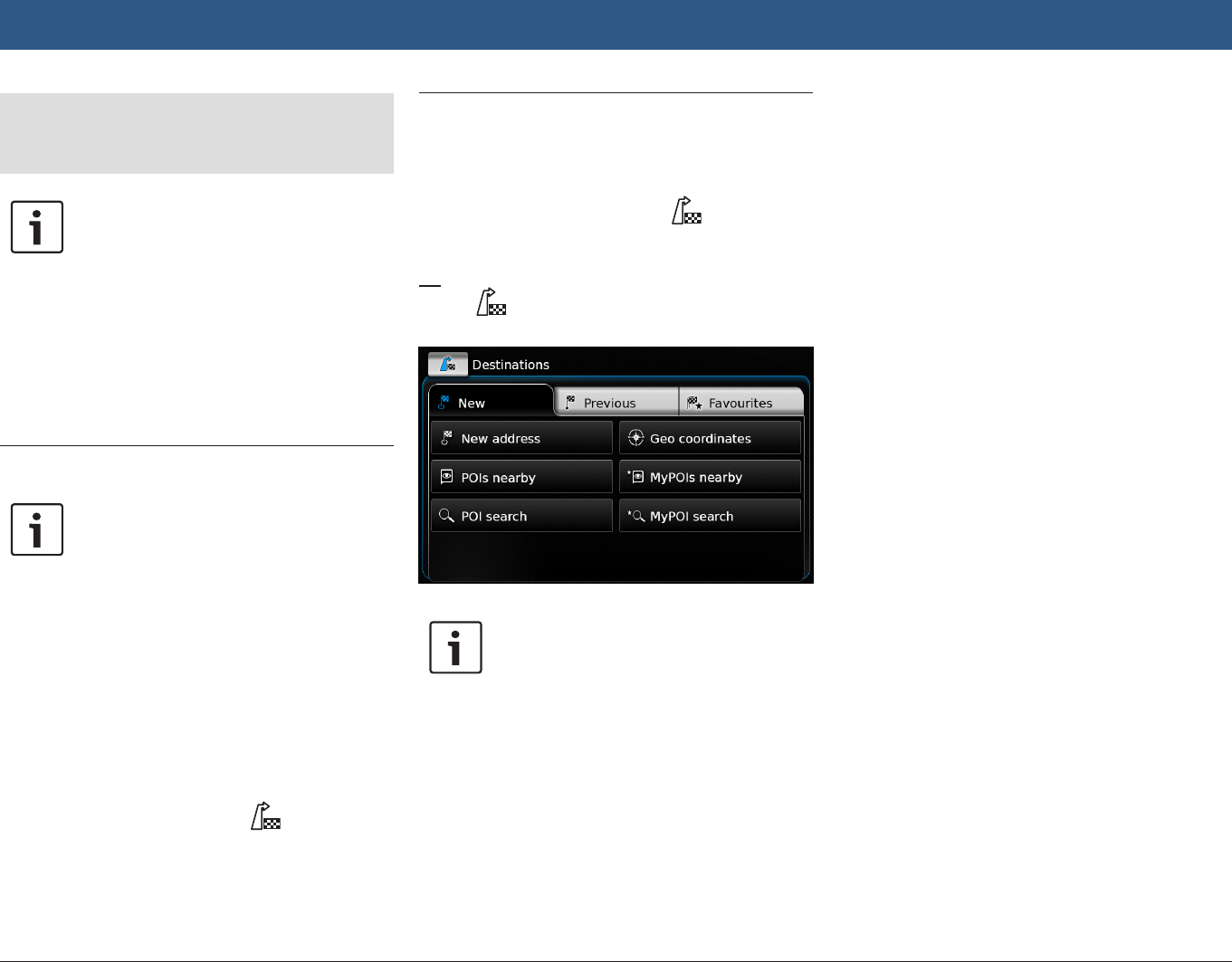
en | 39
map. If a navigation instruction
contradicts traffic regulations, the
traffic regulations always apply.
Note:
This navigation system calculates the
current vehicle position using satellite
signals, various vehicle signals, map
data, etc. However, an accurate posi-
tion may not be shown depending on
satellite condition, Road configuration,
vehicle condition or other circum-
stances.
8.1 Starting navigation
Note:
Ensure that the SD card containing the
navigation system’s map data is
inserted in the SD card slot 3.
The navigation function is only avail-
able when the SD card containing the
map data is inserted.
To open the map view,
ftap the Drive area in the Home menu.
To open the Destinations menu,
ftap the direct-select button in the Home
menu.
8.2 Entering a destination
8.2.1 Opening the Destinations
menu
fTap the direct-select button in the Home
menu.
or:
fTap in the map view.
The Destinations menu is displayed:
Note:
If a route guidance session is active,
the Route menu of the Destinations
menu will be displayed. For more
details please refer to the section
entitled “Route guidance settings in the
Route menu” (page 46).
Under the New tab, you can specify a new desti-
nation.
Please refer to the sections “Entering an
address” (page 39) and “Selecting a point of
interest” (page 41).
If you switch to the Previous tab or Favourites
tab, you can select a previous destination or a
stored favourite as your new destination.
Please refer to the section entitled “Selecting
one of the previous destinations or a destination
stored as a favourite” (page 42).
8.2.2 Entering an address
fIn the Destinations menu, tap the New tab, if
necessary.
fTap New address.
The Address input menu is displayed.
Enter the following address components in this
order:
1. Country
2. City / Postcode
3. Street
4. Intersection or House number
To enter an address component,
ftap the relevant item.
Navigation
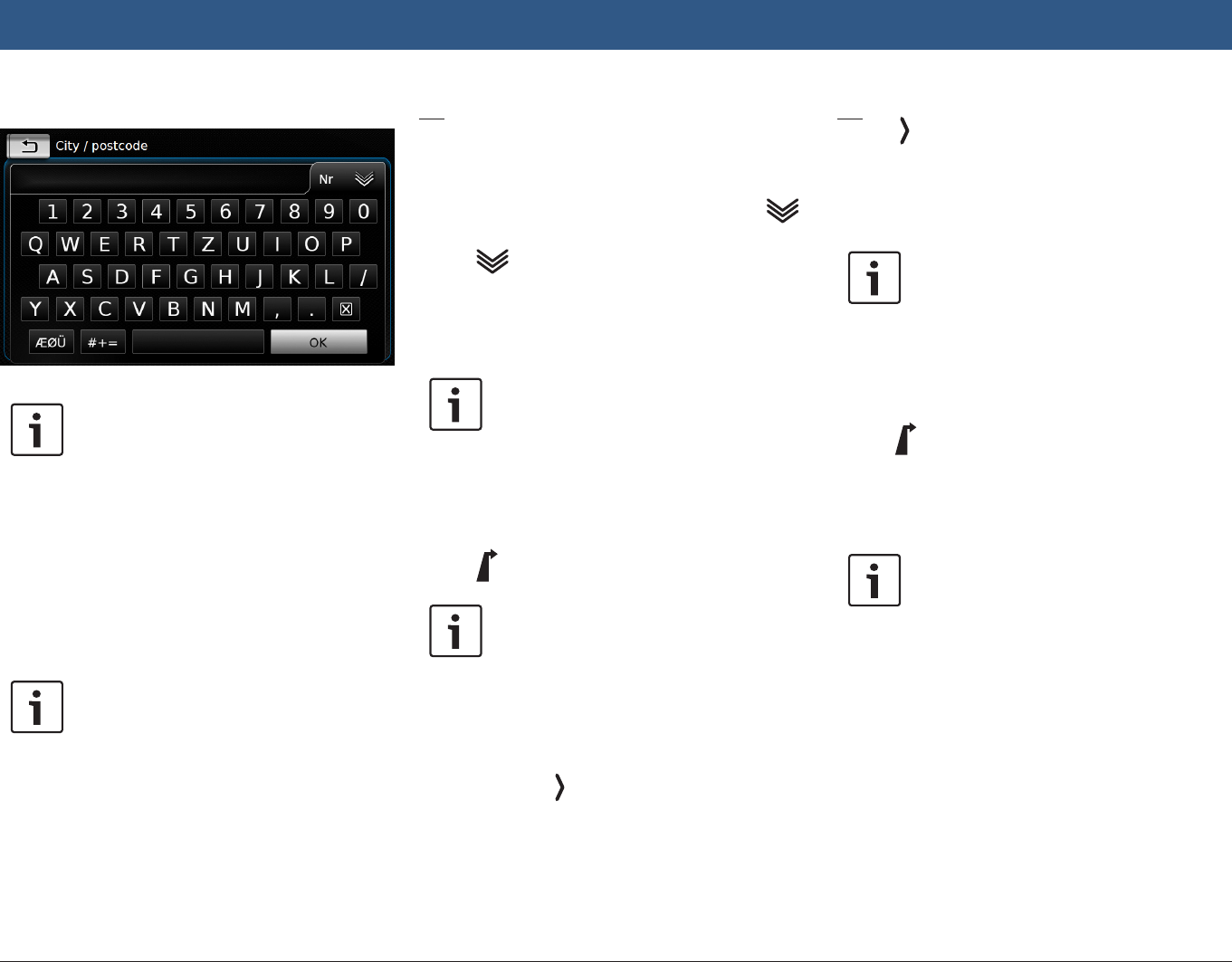
40 | en
The keypad is displayed:
Note:
If the “Lock keypad while driving”
setting is enabled, you will only be able
to access the keypad while the vehicle
is stationary. For further details on
this, please read the section entitled
“Enabling the keypad lock while driv-
ing” (page 54).
fEnter the relevant name or number.
Note:
If necessary, tap ÆØÜ to show the
special characters on the keypad.
The first suitable match found for what you have
entered is displayed above the keypad.
fTap OK to select the displayed match.
Or:
fEnter the first characters of the address
component.
The number of matches corresponding to the
entered characters is displayed beside the
symbol.
fTap to display the list of matches.
fTap the desired match.
The Address input menu is displayed.
fProceed with the next address component.
Note:
As soon as you have entered the coun-
try and city of your destination, you
can start route guidance. You will then
automatically be guided to the city
centre.
fTap to start route guidance.
Note:
If the entered address is ambiguous, a
list of possible destinations is dis-
played.
fTap the desired item to start route
guidance to the respective destina-
tion.
fTap for an item to view the details
for the respective destination
before starting route guidance (see
the section entitled “Location
details view” (page 42)).
Or:
fTap to view the details for the respective
destination and a map of the surrounding
area (see the section entitled “Location
details view” (page 42)).
Note:
If the entered address is ambiguous, a
list of possible destinations is dis-
played. Tap the desired item to view
the details for the respective destina-
tion.
fTap to start route guidance.
The system calculates the route to the selected
destination.
Note:
If a route guidance session is already
active, you can choose
fwhether the current destination or,
if applicable, the current waypoint
should be replaced by the new
destination (see the section entitled
“Changing the destination while
route guidance is active” (page
44))
or
fwhether the new destination should
be added to the current route as a
waypoint (see the section entitled
Navigation

en | 41
“Entering a waypoint” (page
44)).
8.2.3 Selecting a point of interest
Methods for searching for a point of interest
There are 2 methods for searching for a point of
interest:
fMethod 1: You can search for a point of inter-
est that is located in a particular city or post-
code area.
fMethod 2: You can search for a point of inter-
est that is located near your current position.
Notes:
fYou can use both methods to search
for a point of interest stored in the
map data or in your own points of
interest.
fYou will find further information on
your own points of interest in the
section entitled “Your own points of
interest” (page 52).
Follow the steps of the desired method as
described below and continue reading the sec-
tion “Selecting a point of interest and starting
route guidance” (page 41).
fMethod 1: Point of interest in a city or post-
code area:
fIn the Destinations menu, tap the New
tab.
fTap POI search or MyPOI search.
The Address input menu is displayed.
fEnter a country and a city or postcode for
the point of interest, as described in the
section entitled “Entering an address”
(page 39).
fTap POI search.
The available point of interest categories are
displayed.
fMethod 2: Point of interest nearby:
fIn the Destinations menu, tap the New
tab.
fTap POIs nearby or MyPOIs nearby.
The available point of interest categories are
displayed.
Note:
Up to 30 available points of interest
inside a 150 km radius around your
current position are listed.
Selecting a point of interest and starting route
guidance
The available points of interest are divided into
categories such as Emergency and Automotive.
fTap the desired category.
Or:
fTap All categories to display all of the avail-
able points of interest.
Notes:
fA category may contain further
subcategories. For example, the
Automotive category is divided into
subcategories such as Petrol station
and Garage. Keep selecting the
desired subcategories until the
points of interest are displayed.
fYou can also use a search term to
find one or more particular points of
interest. To do so, tap Search, enter
the desired search term and confirm
by tapping OK.
fTap the desired point of interest.
Details about the point of interest and a map of
the surrounding area are displayed (see the
section entitled “Location details view” (page
42)).
fTap to start route guidance.
The system calculates the route to the selected
destination.
Note:
If a route guidance session is already
active, you can choose
fwhether the current destination or,
if applicable, the current waypoint
should be replaced by the new
destination (see the section entitled
“Changing the destination while
Navigation
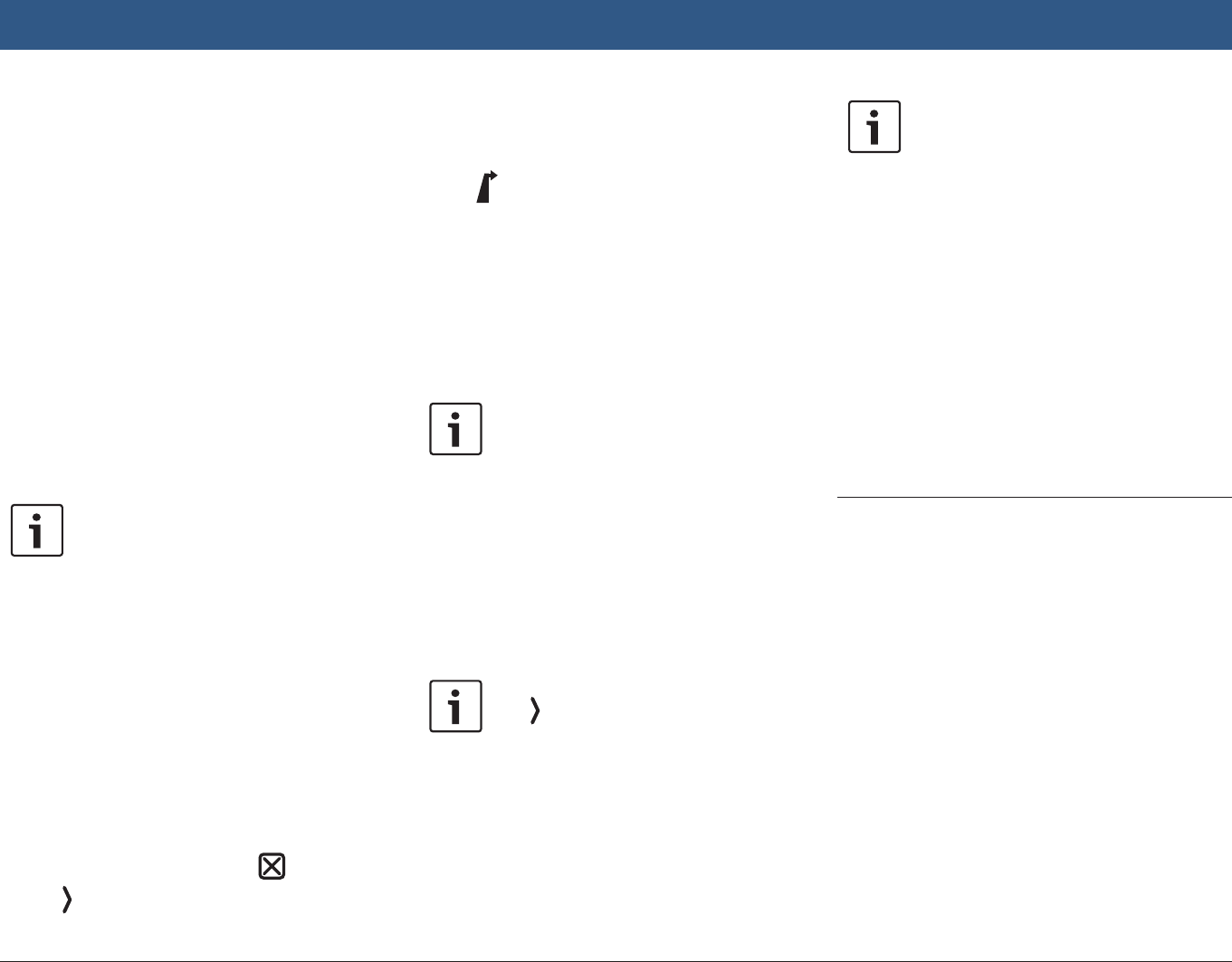
42 | en
route guidance is active” (page
44))
or
fwhether the new destination should
be added to the current route as a
waypoint (see the section entitled
“Entering a waypoint” (page
44)).
8.2.4 Entering coordinates
fIn the Destinations menu, tap the New tab, if
necessary.
fTap Geo coordinates.
The Enter Geo coordinates menu is displayed.
fEnter the coordinates.
Notes:
fYou can select in which format
coordinates are specified (see the
section entitled “Selecting the geo
coordinate format” (page 55)).
fIn order to enter the values of a
cordinate, first tap the respective
input field. Then enter the value by
tapping the respective digit on the
numeric keypad.
fIf you want to enter coordinates for
the southern or eastern hemi-
sphere, tap N or W.
fIf you enter a wrong digit, you can
delete it by tapping .
fTap .
Details about the location and a map of the
surrounding area are displayed (see the section
entitled “Location details view” (page 42)).
fTap to start route guidance.
8.2.5 Selecting one of the previous
destinations or a destination
stored as a favourite
fIn the Destinations menu, tap the Previous
tab or Favourites tab.
The available destinations are displayed.
Note:
Under the Favourites tab, you will find
your Home address at the top of the
list. To specify and store the home
address, please read the section enti-
tled “Storing the home address” (page
44).
fTap the desired destination to start route
guidance.
Note:
Tap for an item to view the details
for the respective destination before
starting route guidance (see the sec-
tion entitled “Location details view”
(page 42)).
The system calculates the route to the selected
destination.
Note:
If a route guidance session is already
active, you can choose
fwhether the current destination or,
if applicable, the current waypoint
should be replaced by the new
destination (see the section entitled
“Changing the destination while
route guidance is active” (page
44)) or
fwhether the new destination should
be added to the current route as a
waypoint (see the section entitled
“Entering a waypoint” (page
44)).
8.3 Location details view
For the following locations or destinations you
can display a details view:
fPoints of interest
fPrevious destinations
fFavourites
fNew destinations
Navigation

en | 43
8.3.1 Areas of the location details
view
53 5452
59 58 5657 55
You will find the following information and con-
trols in the details view:
g Map of the area around the location
h Slider
i Address information
j button: Call the stored number (only if
a number is stored)
k button: Start route guidance
l button: Save as favourite
If the location is already a favourite:
button: Edit the name of the favourite
m button: Delete the location (only for
previous destinations, favourites or way-
points)
n button: Delete all locations of the list
(either previous destinations, favourites
or waypoints)
You can adjust the size of the map g and the
information area i:
fTouch the slider h and swipe left or right.
8.3.2 Options in the location
details view
In addition, you have these options available to
you (depending on the type of location):
fYou can store a location in your favourites. To
do so, tap l. Then you have the follow-
ing options:
– Tap Edit name to edit the name of the new
favourite before saving it.
– Tap Save with displayed name to save
the new favourite without editing the
name.
– Tap Save as home to store the favourite
as the home address (see also the section
entitled “Storing the home address” (page
44)).
Notes:
fIf you want to rename the destina-
tion, enter a name for it using the
keypad. If necessary, tap ÆØÜ to
show the special characters on the
keypad. Tap OK to store the destina-
tion under the entered name.
fIf you want to store the favourite as
the home address and a home
address is already stored, you are
prompted to confirm the replace-
ment of the existing home address.
fIf all the storage spaces for your
favourites are already occupied, a
corresponding notification appears
and allows you to replace an existing
favourite.
fIf the location is already a favourite, you can
rename the favourite. To do so, tap l
and confirm by tapping OK.
fA telephone number is stored for some loca-
tions. Tap j to call this number.
Note:
A mobile phone must be connected to
the device for this function.
fTo delete the displayed location from the list
of previous destinations, from your favourites
or from the list of waypoints, tap m and
confirm by tapping .
fTo delete all previous destinations, favourites
or waypoints and the final destination of an
active route guidance session, tap n
and confirm by tapping .
Navigation
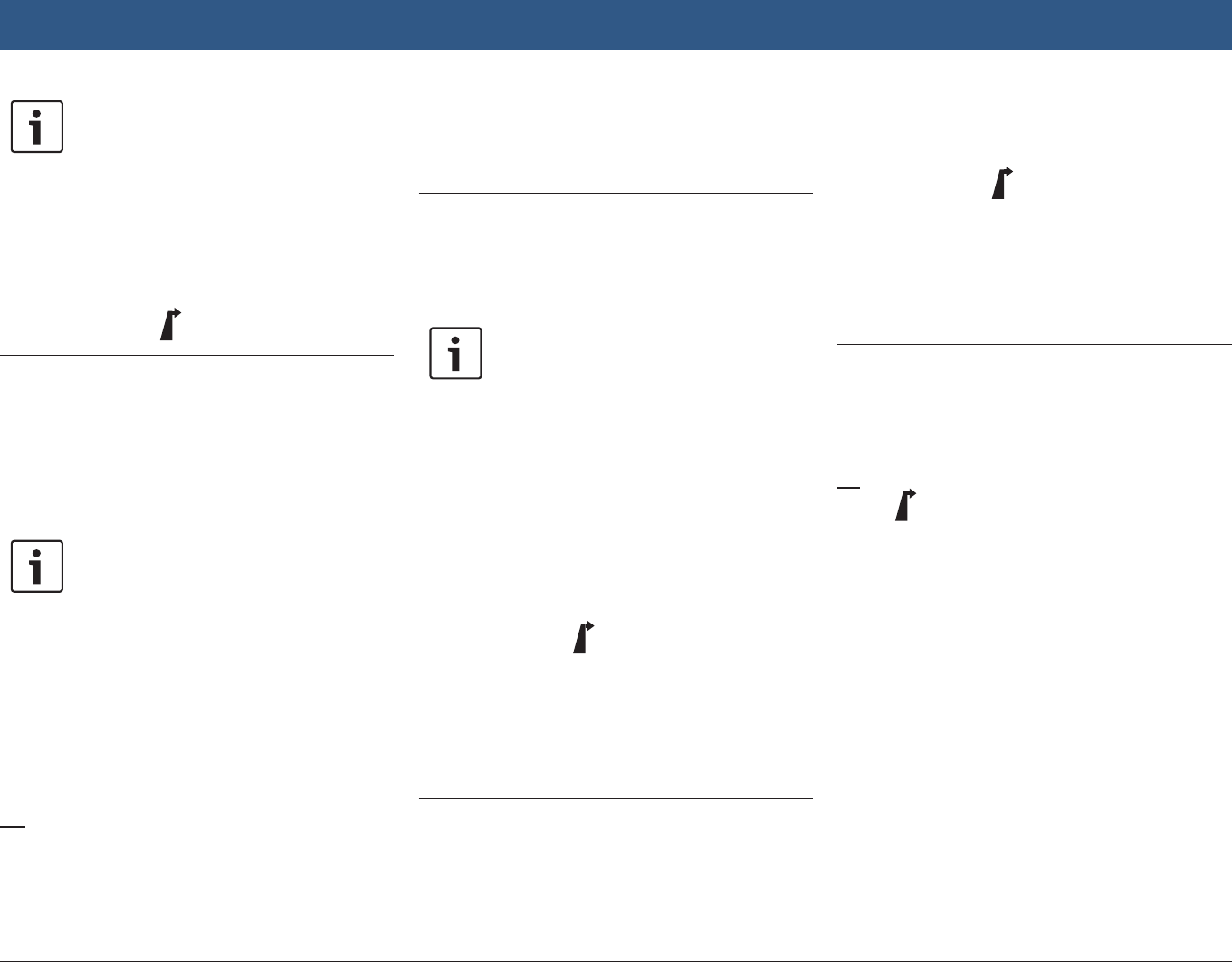
44 | en
Notes:
fIf you delete a waypoint, the route is
recalculated and displayed in the
map view.
fIf you delete all waypoints and the
final destination, the route guidance
session is cancelled.
fTo start route guidance from within the
details view, tap k.
8.4 Storing the home address
You can store a home address. This address
appears at the top of the list of your favourites
(see the section entitled “Selecting one of the
previous destinations or a destination stored as
a favourite” (page 42)).
Note:
If a home address has already been
stored, it will be replaced/overwritten
by the new address after confirmation.
fIn the Destinations menu, tap the Favourites
tab.
fTap Home.
fTap Current position to store the current
position as the home address.
Or:
fTap Enter address to specify an address.
fEnter the address as described in the section
entitled “Entering an address” (page 39).
fAfter specifying the address, tap Set as
home to store the entered address as the
home address.
8.5 Entering a waypoint
As soon as you have started route guidance to a
destination, you can enter up to 5 further desti-
nations as waypoints.
Note:
The order in which you enter additional
waypoints cannot be changed after-
wards. Each waypoint that you add will
be placed on the route before the desti-
nation. So the last waypoint that you
add will be the last waypoint on your
route.
fEnter the new destination as described in the
section entitled “Entering a destination”
(page 39).
As soon as you tap , the Route guidance is
active notification appears.
fTap Add as waypoint.
The new destination is inserted in the route as a
waypoint. The system calculates the route to the
waypoint.
8.6 Changing the destination while
route guidance is active
You can change the destination or waypoint
while route guidance is active.
fEnter the new destination as described in the
section entitled “Entering a destination”
(page 39).
As soon as you tap , the Route guidance is
active notification appears.
fTap Replace destination or Add as way-
point.
The system calculates the route to the new
destination.
8.7 Map view and map options
8.7.1 Opening the map view
fTap the Drive area in the Home menu.
or:
fTap in the Destinations menu.
8.7.2 The map view during an
active route guidance session
An active route guidance session is displayed in
the map view. Driving recommendations are
provided in visual form (see below) and as
announcements.
Navigation